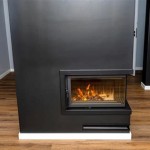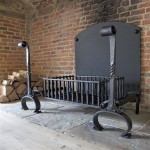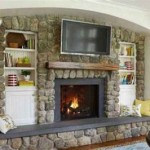How To Fix Gas Smell From Fireplace When Off
A gas fireplace offers warmth and ambiance, but that comfort can be quickly overshadowed by the disconcerting smell of gas when the fireplace is not in use. This odor, even if faint, should never be ignored as it may indicate a potential safety hazard. Addressing the root cause of the gas smell is imperative to ensure the safety and well-being of the occupants of the home. This article provides a comprehensive guide to identifying, troubleshooting, and resolving the issue of gas smells emanating from a gas fireplace when it is turned off.
The presence of a gas smell, often described as being similar to rotten eggs, signals the presence of mercaptan, a harmless but pungent chemical added to natural gas and propane. These gases are naturally odorless, making mercaptan a crucial safety feature, allowing for the detection of leaks even in small concentrations. If a gas odor is perceived, immediate and methodical action is required to identify and remedy the problem. It is important to distinguish between a fleeting, minor odor and a persistent, strong smell. A brief whiff might be attributed to recent fireplace use, while a continuous or intensifying odor warrants immediate investigation.
Before attempting any troubleshooting or repair, it is crucial to prioritize safety. If a strong gas odor is detected, the following steps should be taken immediately: extinguish all open flames, including candles and pilot lights (if safe to reach); refrain from using electrical switches, telephones, or anything that could create a spark; open windows and doors to ventilate the area; and evacuate the premises. Once safely outside, contact the local gas company or fire department to report the leak. Do not re-enter the building until authorized by a qualified professional.
Identifying Potential Causes of Gas Smell
Once the immediate safety concerns have been addressed, the focus shifts to pinpointing the source of the gas smell. Several potential scenarios can contribute to the issue, ranging from simple solutions like a dirty fireplace to more complex problems involving gas line leaks. A systematic approach to investigation is essential.
One common culprit is a dirty fireplace. Dust, debris, and accumulated soot can trap residual gas, releasing the odor even when the fireplace is off. This is particularly true after a period of infrequent usage. The accumulated debris can also interfere with the proper sealing of the gas valve, allowing small amounts of gas to escape. In addition, spiders and insects can build nests within the fireplace components, further obstructing airflow and contributing to the accumulation of gas and associated odors.
Another potential cause lies within the pilot light assembly. Even when the main burner is off, a standing pilot light (if equipped) continuously consumes a small amount of gas. A faulty or improperly adjusted pilot light can lead to incomplete combustion, resulting in the release of unburnt gas. Furthermore, the pilot light assembly itself can develop leaks or damage over time, particularly the thermocouple or thermopile, which are responsible for ensuring the gas valve remains open. A malfunctioning thermocouple or thermopile can cause the pilot light to extinguish intermittently, leading to a buildup of gas before the safety valve shuts off.
Gas line leaks represent a more serious potential cause. These leaks can occur at various points along the gas line, including connections, fittings, and even the pipe itself due to corrosion or damage. Even a small leak can produce a noticeable odor, especially in enclosed spaces. Gas leaks can also originate from the gas valve itself, which is designed to regulate the flow of gas to the burner. A malfunctioning gas valve may not completely shut off the gas supply when the fireplace is turned off, allowing a small but constant leak to occur.
The fireplace damper, if applicable, can also contribute to gas odors. A closed damper prevents airflow through the chimney, potentially trapping any residual gas within the fireplace and intensifying the smell. Conversely, a damper that does not seal properly can allow drafts to push gas odors into the living space. Additionally, if the chimney is blocked by debris, animals, or other obstructions, it can prevent proper ventilation, forcing gas odors back into the room.
Troubleshooting and Repairing the Gas Smell
Once potential causes have been identified, the next step involves troubleshooting and implementing appropriate repairs. It is crucial to proceed with caution and to contact a qualified HVAC technician or gas fireplace specialist if the problem is complex or if there is any uncertainty regarding the repair process. Attempting repairs without proper knowledge and experience can be dangerous and potentially lead to further damage or safety hazards.
The first step in troubleshooting is to thoroughly inspect the fireplace. Begin by visually examining the area for any obvious signs of damage, such as cracked or corroded pipes, loose connections, or debris accumulation. Use a flashlight to illuminate hard-to-reach areas. Carefully examine the gas line connections for any signs of leaks. A simple test involves applying a soapy water solution to the connections and looking for bubbles, which would indicate a leak. However, this test should be performed with extreme caution and only if the gas smell is faint and localized.
If a dirty fireplace is suspected, a thorough cleaning is recommended. Start by turning off the gas supply to the fireplace at the shut-off valve, typically located near the fireplace or in an adjacent room. Allow the fireplace to cool completely before proceeding. Use a vacuum cleaner with a brush attachment to remove loose dust and debris from the fireplace interior, including the logs, burner, and surrounding surfaces. A soft brush can be used to gently scrub any stubborn soot or residue. Pay particular attention to the pilot light assembly, ensuring it is free of obstructions. Once the cleaning is complete, reassemble the fireplace components and turn the gas supply back on. Monitor the area for any lingering gas odors.
If the pilot light is suspected of malfunctioning, inspect the thermocouple or thermopile for damage or wear. A faulty thermocouple or thermopile can often be replaced, but it is crucial to use a compatible replacement part. If the pilot light flame appears weak or unstable, it may need to be adjusted. Refer to the fireplace manufacturer's instructions for guidance on adjusting the pilot light. If the pilot light continues to malfunction after inspection and adjustment, it may be necessary to replace the entire pilot light assembly.
If a gas line leak is suspected, it is imperative to contact a qualified gas technician immediately. Do not attempt to repair gas line leaks yourself, as this can be extremely dangerous. A qualified technician will have the necessary tools and expertise to properly locate and repair the leak, ensuring the safety of the occupants of the home. The technician may use specialized equipment, such as a gas leak detector, to pinpoint the exact location of the leak and perform the necessary repairs. This may involve tightening loose connections, replacing damaged pipes, or repairing the gas valve.
The fireplace damper should also be inspected. Ensure that the damper is functioning properly and that it seals tightly when closed. If the damper is damaged or not sealing correctly, it may need to be repaired or replaced. If the chimney is suspected of being blocked, a professional chimney sweep should be hired to inspect and clean the chimney. A blocked chimney can not only cause gas odors but also pose a serious fire hazard.
Preventative Measures to Minimize Gas Odors
Preventing gas odors from recurring involves implementing regular maintenance practices and addressing potential issues proactively. Regular maintenance not only ensures the safe operation of the fireplace but also extends its lifespan and improves its efficiency. A proactive approach can minimize the risk of gas leaks and prevent the buildup of gas odors.
Annual inspection and maintenance by a qualified technician are highly recommended. A technician can thoroughly inspect the fireplace components, including the gas line, gas valve, pilot light assembly, and burner, to identify any potential issues before they escalate into major problems. The technician can also perform necessary cleaning, adjustments, and repairs to ensure the fireplace is operating safely and efficiently. A carbon monoxide detector should also be installed and tested regularly to provide an early warning of carbon monoxide buildup, which can occur due to incomplete combustion in the fireplace.
Regular cleaning of the fireplace is essential to prevent the accumulation of dust, debris, and soot. Clean the fireplace at least once a year, or more frequently if it is used regularly. This involves vacuuming the interior, cleaning the logs and burner, and removing any obstructions from the pilot light assembly. The chimney should also be inspected and cleaned periodically to ensure proper ventilation. A clean fireplace is less likely to trap residual gas and emit unpleasant odors.
Proper ventilation is crucial for preventing gas odors. Ensure that the fireplace damper is functioning correctly and that the chimney is free of obstructions. When using the fireplace, open the damper fully to allow for proper airflow. Avoid using the fireplace for extended periods without adequate ventilation, as this can lead to the buildup of carbon monoxide and other harmful gases. If the fireplace is located in a small or enclosed space, consider installing a vent to provide additional ventilation.
Promptly address any suspected gas leaks or malfunctions. If a gas odor is detected, even if it is faint, investigate the source immediately and take appropriate action. Do not ignore the smell or attempt to cover it up. Contact a qualified technician to inspect and repair any gas line leaks or malfunctioning components. Delaying repairs can increase the risk of a gas leak and potentially lead to a dangerous situation.
By following these preventative measures and addressing any gas odors promptly, the safety and comfort of the home can be insured and the enjoyment of the gas fireplace can be continued without concern.

Here S Why Your Gas Fireplace Stinks Full Service Chimney

Troubleshooting Gas Fireplace Issues St Louis Mo English Sweeps

Gas Fireplaces Are Popular Convenient But Still Require Maintenance

How To Get Rid Of Fireplace Smell Vertical Chimney Care

Gas Fireplace Safety 9 Essential Questions Answered We Love Fire

Fireplace Gas Valve Leaking Here S How To Test It

Gas Fireplace Odours Causes And Solutions Prowest Heating

Vent Free Fireplace Odor

Six Reasons Why Your Fireplace Smells Bad We Love Fire

Here S Why Your Gas Fireplace Stinks Full Service Chimney
Related Posts








